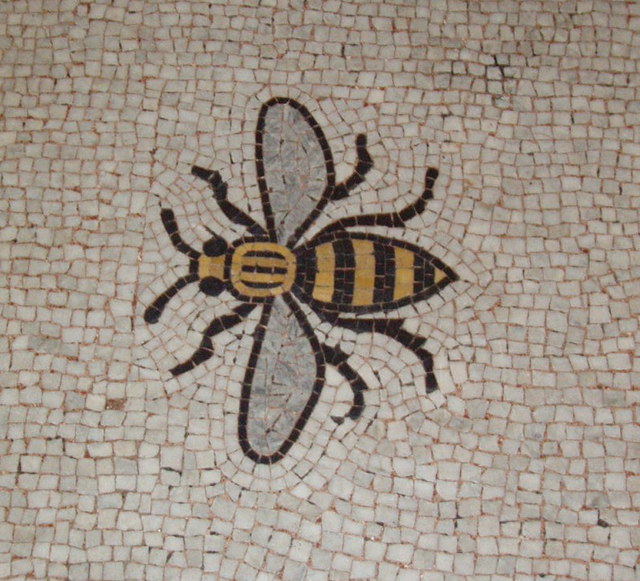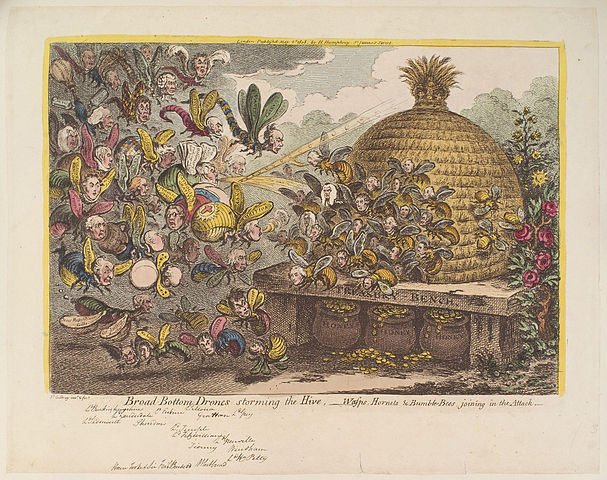
The Thammasat University Libraries have newly acquired an essential book for understanding the behavior of bees. Dr. Karl von Frisch, a Nobel Prize-winning biologist, wrote Bees: Their Vision, Chemical Senses, and Language. If you have ever wondered how the world looks and smells to a bee, this book will inform you. How bees communicate by dancing and using the sun to tell what direction they should fly in are also explained. Among unsuspected findings are that bees are much more sensitive to color than was previously thought.
The TU Libraries owns several books on the same subject, including The Fascinating World of Bees, and Biodiversity of Honey Bees in Thailand. Anyone in the mood for a scary documentary video might wish to see Attack of the Killer Bees, a National Geographic film in the collection of the Rewat Buddhinan Center.
Bees in Thailand
When bees are discussed in the media, it is often in the context of attacks. In 2012 the BBC reported that 76 monks from the Chedi Luang temple in Chiang Mai province had to visit hospitals after being stung by a swarm of bees. Nineteen of the monks were in serious condition, and six were in a coma, with low blood pressure. Reports explained that the temple keeps beehives to produce wax for making candles. Usually bees attack when the feel threatened, so it is not certain why this incident occurred.
Fortunately, most people in the Kingdom have a better experience with bees. In 2014 The Nation reported that the Thai health export company Bees Knees Ltd. was promoting a Save the Honeybees campaign. Khun Promruck Limsodsai, managing director of Bees Knees Ltd, said about bees: For such small, short-lived creatures, they do a lot of heavy lifting to keep life on earth in balance. Today, though, bees are in trouble. Seemingly healthy bees are simply abandoning their hives en masse, never to return, and this phenomenon is called Colony Collapse Disorder. The consequence of a dying bee population impacts man at the highest levels of our food chain, posing an enormously grave threat to human survival. We should not let that happen…A third of what we eat is made possible by bees. Oranges, chocolate, artichokes, apples, carrots, tomatoes, cashews, garlic and cherries are just a few foods that rely upon pollination to grow and reproduce. We need bees, and now, they need us, too.
Homeowners may help by growing more flowers, which might attract bees, always looking for pollen and nectar. This in turn assists in pollination. To avoid the possibility of being stung, just try not to disturb the bees.

Bee farming in Thailand.
Also in 2014, the Free Trade Agreement Fund agreed to help support Thai honey farmers challenged by competition under trade liberalization with China, Japan, New Zealand, Australia and other countries. After this liberalization, some businesses have diluted Thai honey, mixing it with honey from other sources. The resulting product is then exported overseas as Thai honey, but is in fact of much less quality than the genuine article.
This procedure has been described in the press as honey-laundering, with a play on words from the term for the notorious illegal activity of money laundering. Real Thai honey is a pure quality item, Assistant Professor Pichai Kongpitak, a plant pathology lecturer at Chiang Mai University and a project manager under the FTA Fund, told The Nation. Ajarn Pichai explained that honey farmers due to receive money from the fund were located in Chiang Mai, Lamphun, Lampang, Nan, Phayao, and other northern locations. With the extra funds, farmers will be encouraged to avoid using too many chemicals in raising the bees, and also devise more sophisticated quality control measures.
Byproducts from this farming include lotions, shower creams, supplements and other cosmetics. Thai honey will be given a trademark, guaranteeing that it is 100 percent pure. As of 2014, there were 1,588 registered honey farms in the Kingdom with 206,412 hives annually producing 10,000 tons of honey, 200 tons of royal jelly and 100 tons of bee pollen. Thai honey is exported in large quantities to Germany, the USA, Saudi Arabia, China, Belgium, France, Indonesia and Malaysia. Among agencies supporting the production of honey in the Kingdom are the Beekeeper Association
of Thailand and the Thai Organic Beekeeper Association.
There are also private bee farms such as Supha Bee Farm in Chiang Mai offering resources and information.
In 2012, a seminar at Dokmai Garden in Chiang Mai was given by Ronny Willman, a professional beekeeper from Sweden. He explained that the usual bees involved in mass production of honey in Thailand are the European bee Apis mellifera, a relatively calm species. The main season for collecting nectar to make honey is when longan blossoms are visible.
Longan is a fruit native to northern Thai forests, grown in the Chiang Mai valley. In northern Thailand, bees collect nectar from longan for about six weeks each year during March and April. As the Dokmai Garden website noted:
Longan honey is liquid due to a high amount of fructose, and is most flavourful. When longan is not in blossom other nectar sources are needed for the survival of the bees…The beekeeping technique and many large honey producing companies in Thailand are Taiwanese. A Thai beekeeper can buy or make a simple wooden box with entrance slits and a landing strip… Place the beehive in the shade and avoid straight rows of many hives or it will be hard for the bees to recognize home. A nearby source of water is welcome… Trays with sugary water can be placed inside the beehive during times when nectar is scarce. To make sure the bees do not drown, add some landing sticks. In western beekeeping several boxes are commonly stacked, separated by a grid to prevent the queen from laying eggs. This technique does not work with Thai bees. They stay in the lower box.

Since bees make honey to serve as food in bad weather, or when they cannot flowers, if farmers take the honey, the must substitute something else for the bees to eat. Sugar water is accepted by the bees as a substitute.
In an online interview, a farang beekeeper named Peter from Chiang Mai explained some of his techniques:
The Thai hive system was brought here about sixty years ago by the Taiwanese who planted all the fruit orchards. The system is a single box that holds up to eleven frames. Eight or nine frames will be in the box during the honey season… Other equipment is quite basic; a hive tool, a smoker and sometimes even a bee brush. That is about it. We do not wear a veil or any other special clothing. No gloves and you just wear slippers so it is really very relaxed. Now what that means is that if you are my wife you stand back and supervise. If you are me you get used to bees running up the inside of your trouser leg, sometimes they do not sting. Better to get used to it than to get hot and most of the time I am sting free.
Although much of the equipment used by Thai beekeepers is made in Taiwan, some of the smaller items are made by local small businesses. Peter the beekeeper reported that he buys hives made in Phrae Province. He added:
You can only buy bees from say May – October since May is the end of the Longan honey season and November is the start of the wild flower season and if they have fed the bees and built them up ready for the nectar flow they are not going to sell to you; they will make money with the flow and then sell to you…You harvest every four days during the nectar flow. You spin every frame (including brood) that has any honey. Each frame needs the bees cleared off. Eight or more frames in a hive and say 100 hives at an apiary. It takes a team of people, the frames are spun at the apiary and during the flow you keep going back and doing it again. Often this would be a family business.
Clearly beekeeping can require a lot of work. A specific challenge is the frequent use of insecticides by farmers, which kills off bees as well as less desirable insects. For that reason, beehives do not survive in places where oranges or mangoes are grown, because they are quickly poisoned by pesticides.
Thai honey is popular, especially when bought directly from beekeepers. When purchased at the source, customers feel confident that the honey is not diluted with high-fructose corn syrup (HFCS).
Thai researchers.
Outstanding scientific research in Thailand has explored the risks bees are currently facing. Bee Diversity in Thailand and the Applications of Bee Products is a chapter in an environmental science book from 2011 available online, Changing Diversity in Changing Environment. In it, Drs. Atsalek Rattanawannee and Chanpen Chanchao of the Department of Biology, Faculty of Science, Chulalongkorn University, concluded among other statements:
Not only are bees are very useful as pollinators, but their bee products, especially honey, are economically important. Other than being consumed as food, bee products, especially honey, propolis and bee pollens, have long been used in traditional medicine. They provide many bioactivities, such as antimicrobial, antiinflammatory, free radical scavenging and antiproliferation activities amongst others. Although they are important in agriculture, at present, it is obvious that there is a decrease in the number of hives of these bees. This may be due to a combination of deforestation, hunting, diseases, pesticide and other factors. Thus, it is very important to consider the conservation of bees and promote the bee management in each country.
Pursuing this worthy goal, in the 2012 book Bees: Biology, Threats and Colonies, an informative chapter coauthored by Dr. Guntima Suwannapong, Department of Biology, Faculty of Science, Burapha University, Chon Buri, noted:
Thai people have learned how to hunt honey from wild bee colonies. However, their methods tend to destroy the colony. It is important that education is enhanced that can teach sustainable ways of harvesting honey…The first report of Western-style beekeeping in standard Langstroth hives was recorded in 1940 by Professor Supachai Wattana (Wongsiri et al. 2000). He imported foreign honeybees to study at Chulalongkorn University in Bangkok. In 1953, Professor Saman Worakitta (who at the time served as the Dean of Agriculture at Kasetsart University) introduced European honeybees from Australia and raised them on campus. However, the operation was not successful (Wongsiri et al. 2000). Later, Thailand established a cooperative agreement with Taiwan to exchange and share knowledge related to beekeeping. Taiwan sent bee experts to advise farmers in northern Thailand: however, beekeeping was still quite limited. Until about 1976-1979, private companies hired specialists from Taiwan for management and operation of beekeeping in Thailand (Wongsiri et al. 2000). Since 1980, the Thai government has recognized the importance of bees to the national economy. And as a result the government has a policy to encourage and promote agricultural apiarists. The Ministry of Agriculture and Cooperatives is an agency responsible for promoting and educating farmers on beekeeping.

(All images courtesy of Wikimedia Commons).
